Instructor Planning Guide
Activities
What activities are associated with this chapter?
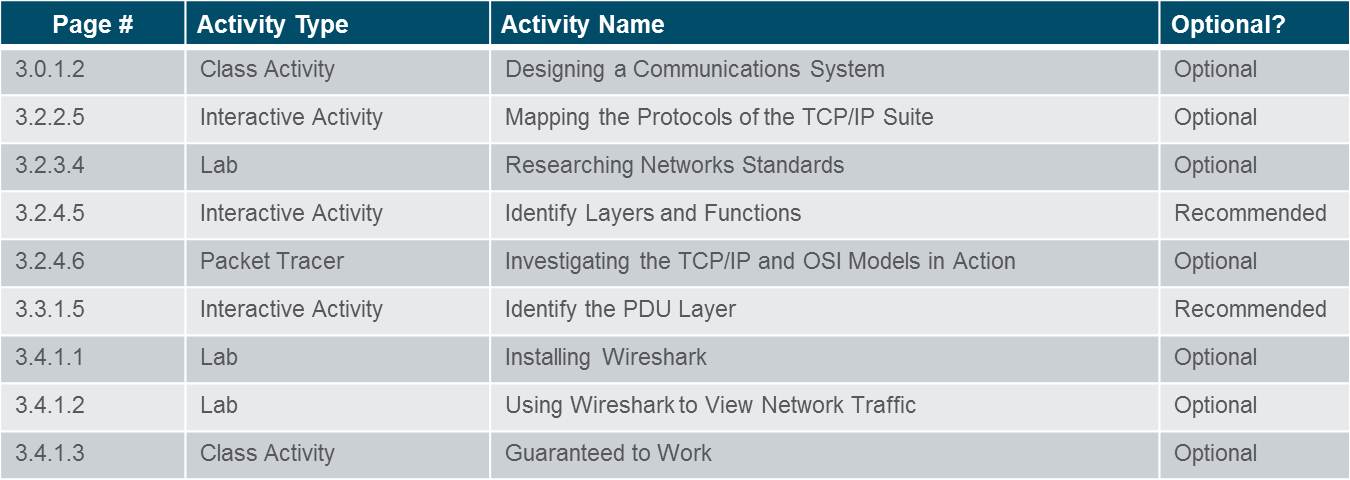
Assessment
Students should complete Chapter 3, “Assessment” after completing Chapter 3.
Quizzes, labs, Packet Tracers and other activities can be used to informally assess student progress.
Sections & Objectives
3.1 Rules of Communication
♦ Explain how rules facilitate communication.
♦ Describe the types of rules that are necessary to successfully communicate.
3.2 Network Protocols and Standards
♦ Explain the role of protocols and standards organizations in facilitating interoperability in network communications.
♦ Explain why protocols are necessary in network communication.
♦ Explain the purpose of adhering to a protocol suite.
♦ Explain the role of standards organizations in establishing protocols for network interoperability.
♦ Explain how the TCP/IP model and the OSI model are used to facilitate standardization in the communication process.
3.3 Data Transfer in the Network
♦ Explain how devices on a LAN access resources in a small to medium-sized business network.
♦ Explain how data encapsulation allows data to be transported across the network.
♦ Explain how local hosts access local resources on a network.
Network Protocols and Communication
3.1 – Rules of Communication
3.1.1 – The Rules
3.1.1.1 – Communication Fundamentals
All communication methods have three elements in common:
Source or sender
Destination or receiver
Channel or media
Rules or protocols govern all methods of communication.
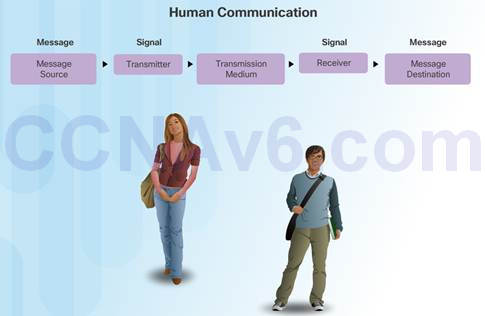
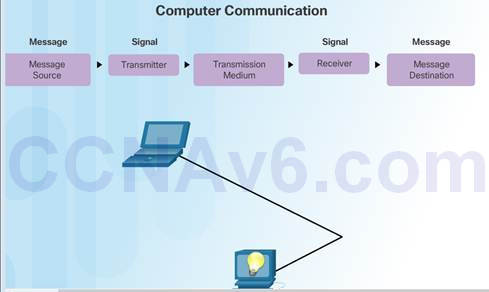
3.1.1.2 – Rule Establishment
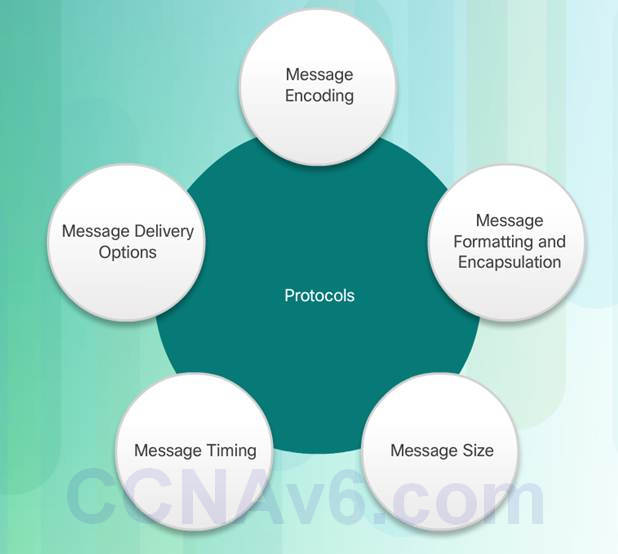
Protocols are necessary for effective communication and include:
♦ An identified sender and receiver
♦ Common language and grammar
♦ Speed and timing of delivery
♦ Confirmation or acknowledgment requirements
Protocols used in network communications also define:
♦ Message encoding
♦ Message delivery options
♦ Message Formatting and Encapsulation
♦ Message Timing
♦ Message Size
3.1.1.3 – Message Encoding
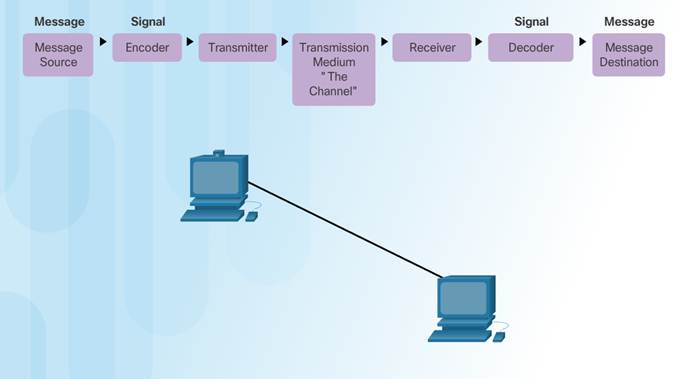
Encoding between hosts must be in appropriate format for the medium.
Messages are first converted into bits by the sending host.
Each bit is encoded into a pattern of sounds, light waves, or electrical impulses depending on the network media
The destination host receives and decodes the signals in order to interpret the message.
3.1.1.4 – Message Formatting and Encapsulation
There is an agreed format for letters and addressing letters which is required for proper delivery.
Putting the letter into the addressed envelope is called encapsulation.
Each computer message is encapsulated in a specific format, called a frame, before it is sent over the network.
A frame acts like an envelope providing destination address and source address.
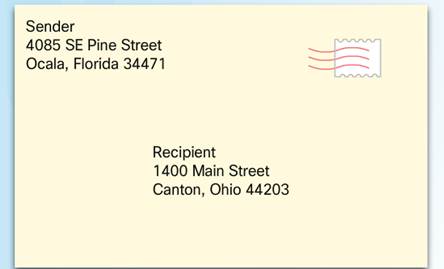

3.1.1.5 – Message Size
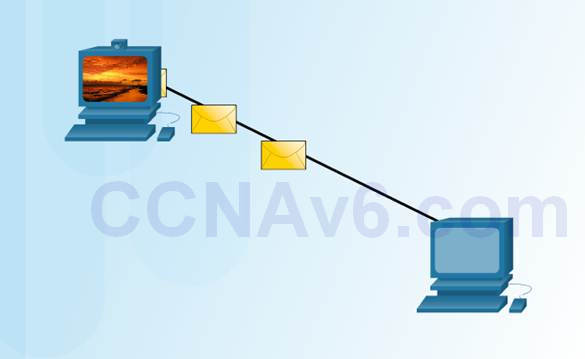
Humans break long messages into smaller parts or sentences.
Long messages must also be broken into smaller pieces to travel across a network.
♦ Each piece is sent in a separate frame.
♦ Each frame has its own addressing information.
♦ A receiving host will reconstruct multiple frames into the original message.
3.1.1.6 – Message Timing
Access Method
♦ Hosts on a network need to know when to begin sending messages and how to respond when collisions occur.
Flow Control
♦ Source and destination hosts use flow control to negotiate correct timing to avoid overwhelming the destination and ensure information is received.
Response Timeout
♦ Hosts on the network have rules that specify how long to wait for responses and what action to take if a response timeout occurs.

3.1.1.7 – Message Delivery Options
Unicast Message
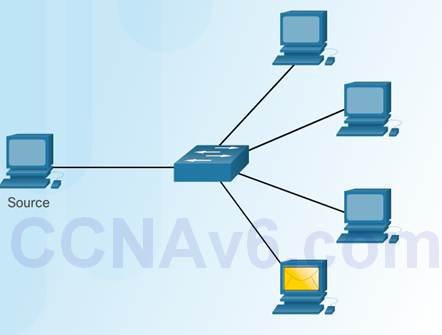
One-to-one delivery
Multicast Message
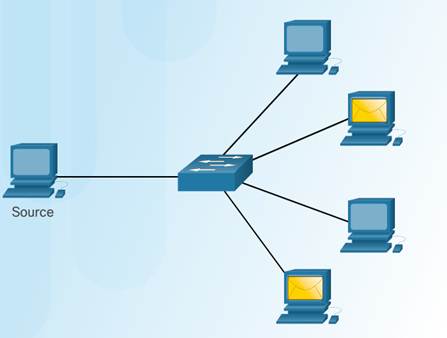
One-to-many delivery
Broadcast Message
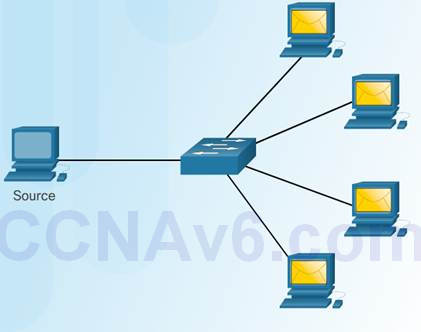
One-to-all deliver
3.2 – Network Protocols and Standards
3.2.1 – Protocols
3.2.1.1 – Rules that Govern Communications
Protocol suites are implemented by hosts and networking devices in software, hardware or both.
The protocols are viewed in terms of layers, with each higher level service depending on the functionality defined by the protocols shown in the lower levels.
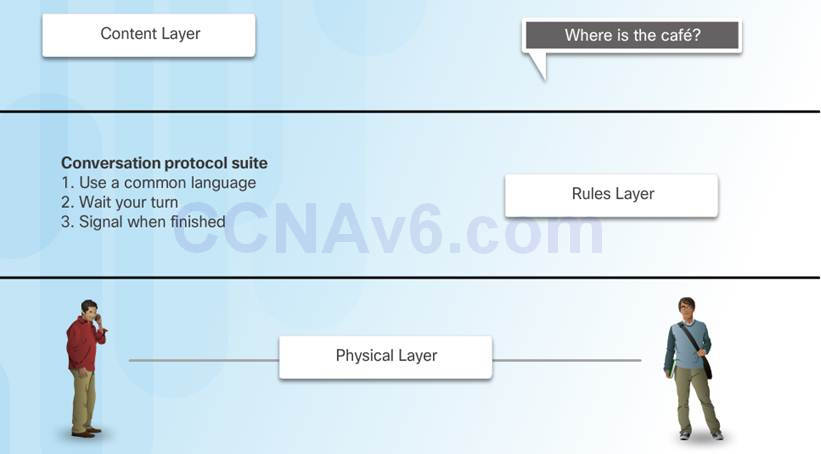
3.2.1.2 – Network protocols
Networking protocols define a common format and set of rules for exchanging messages between devices.
Some common networking protocols are Hypertext Transfer Protocol (HTTP), Transmission Control Protocol (TCP), and Internet Protocol (IP).
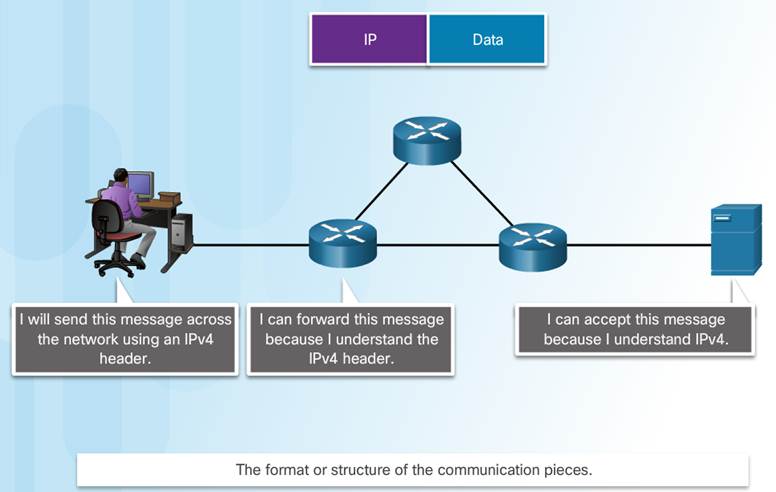
3.2.1.3 – Protocol Interaction
Communication between a web server and web client is an example of an interaction between several protocols:
♦ HTTP – an application protocol that governs the way a web server and a web client interact.
♦ TCP – transport protocol that manages the individual conversations.
♦ IP – encapsulates the TCP segments into packets, assigns addresses, and delivers to the destination host.
♦ Ethernet – allows communication over a data link and the physical transmission of data on the network media.
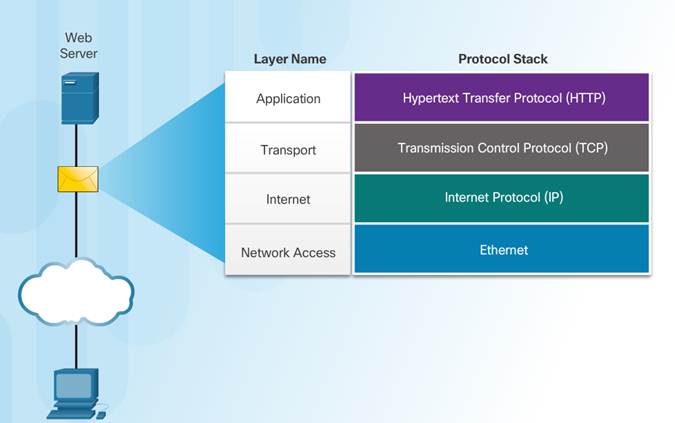
3.2.2 – Protocol Suites
3.2.2.1 – Protocol Suites and Industry Standards
A protocol suite is a set of protocols that work together to provide comprehensive network communication services.
♦ May be specified by a standards organization or developed by a vendor.
The TCP/IP protocol suite is an open standard, the protocols are freely available, and any vendor is able to implement these protocols on their hardware or in their software.
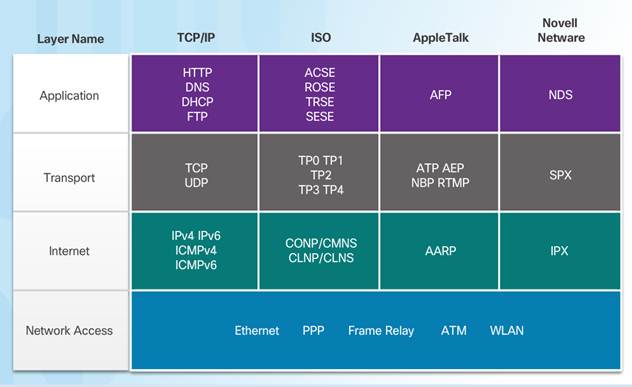
3.2.2.2 – Development of TCP/IP
Advanced Research Projects Agency Network (ARPANET) was the predecessor to today’s Internet.
♦ ARPANET was funded by the U.S. Department of Defense for use by universities and research laboratories.
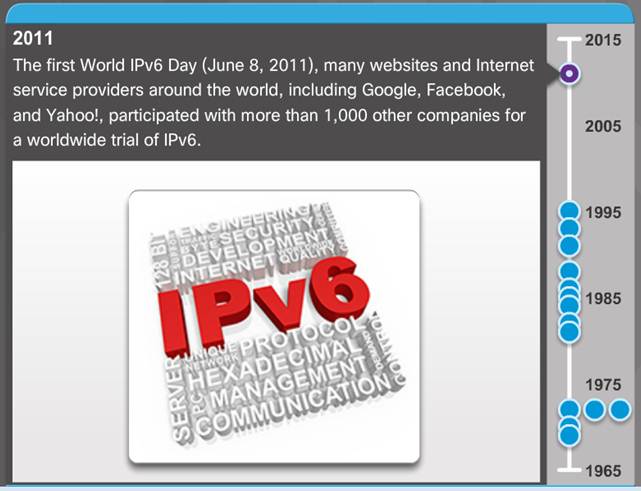
3.2.2.3 –TCP/IP Protocol Suite
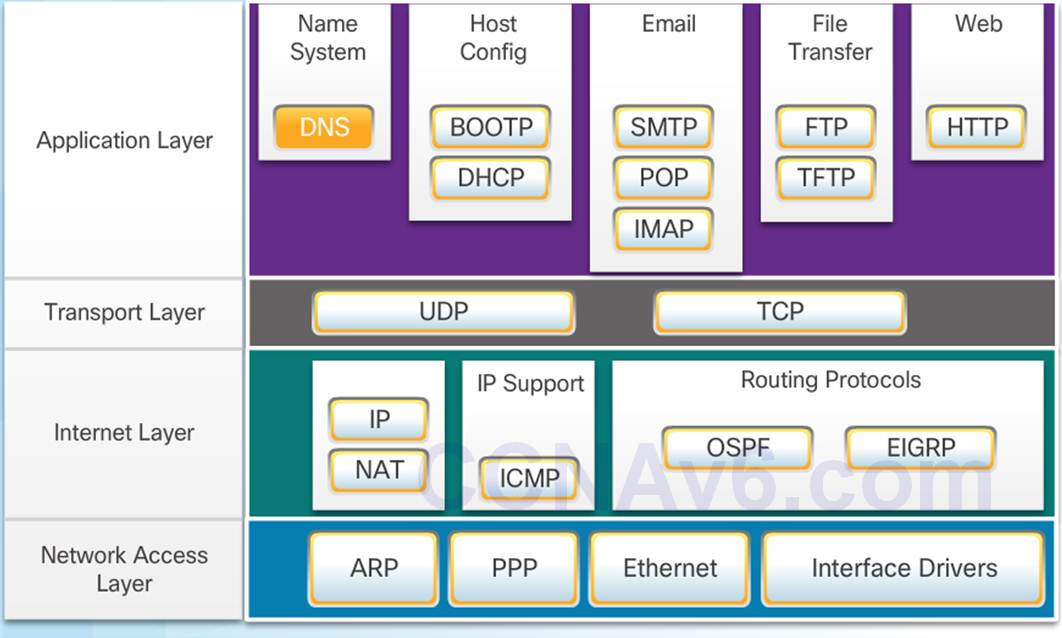
3.2.2.4 – TCP/IP Communication Process
When sending data from a web server to a client the encapsulation procedure would be as follows:
♦ The webserver prepares the Hypertext Markup Language (HTML) page. The HTTP application layer protocol sends the data to the transport layer.
♦ The transport layer breaks the data into segments and identifies each.
♦ Next the IP source and destination addresses are added, creating an IP Packet.
♦ The Ethernet information is then added creating the Ethernet Frame, or data link frame.
♦ This frame is delivered to the nearest router along the path towards the web client. Each router adds new data link information before forwarding the packet.
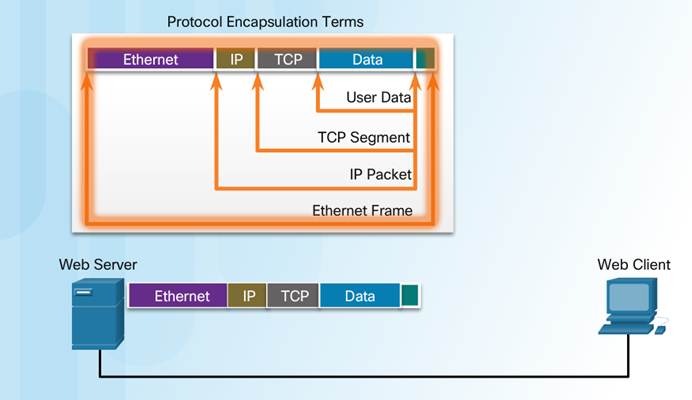
When receiving the data link frames from the web server, the client processes and removes each protocol header in the opposite order it was added:
♦ First the Ethernet header is removed
♦ Then the IP header
♦ Then the Transport layer header
♦ Finally the HTTP information is processed and sent to the client’s web browser
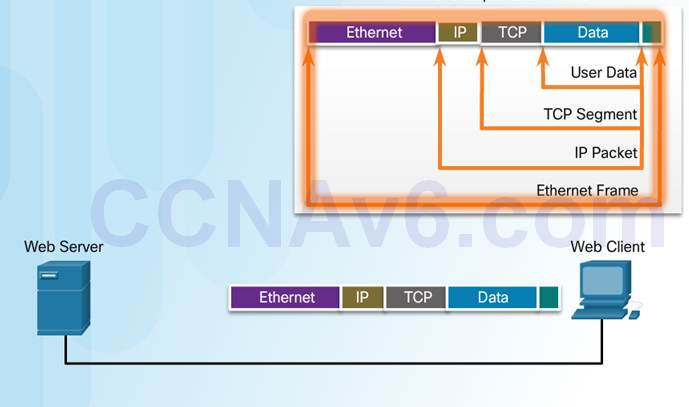
3.2.3 – Standards Organizations
3.2.3.1 – Open Standards
Open standards encourage interoperability, competition, and innovation.
Standards organizations are usually vendor-neutral, non-profit organizations established to develop and promote the concept of open standards.

3.2.3.2 – Internet Standards
Internet Society (ISOC) –promotes open development and evolution of Internet use globally.
Internet Architecture Board (IAB) – management and development of Internet standards.
Internet Engineering Task Force (IETF) – develops, updates, and maintains Internet and TCP/IP technologies.
Internet Research Task Force (IRTF) – focused on long-term research related to Internet and TCP/IP protocols.
Internet Corporation for Assigned Names and Numbers (ICANN) – coordinates IP address allocation and management of domain names.
Internet Assigned Numbers Authority (IANA) – manages IP address allocation, domain name management, and protocol identifiers for ICANN.

3.2.3.3 – Electronics and Communications Standard Organizations
Institute of Electrical and Electronics Engineers (IEEE) – dedicated to advancing technological innovation and creating standards in a wide area of industries including networking.
Electronic Industries Alliance (EIA) – standards related to electrical wiring, connectors, and network racks.
Telecommunications Industry Association (TIA) standards for radio equipment, cellular towers, Voice over IP (VoIP) devices, and satellite communications.
International Telecommunications Union-Telecommunication Standardization Sector (ITU-T) standards for video compression, Internet Protocol Television (IPTV), and broadband communications.
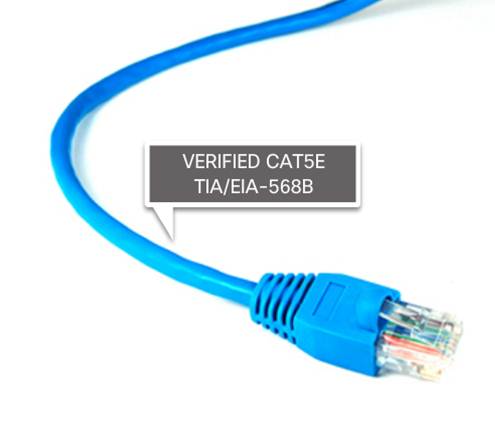
3.2.3.4 – Lab-Researching Networking Standards
3.2.3.4 Lab – Researching Networking Standards
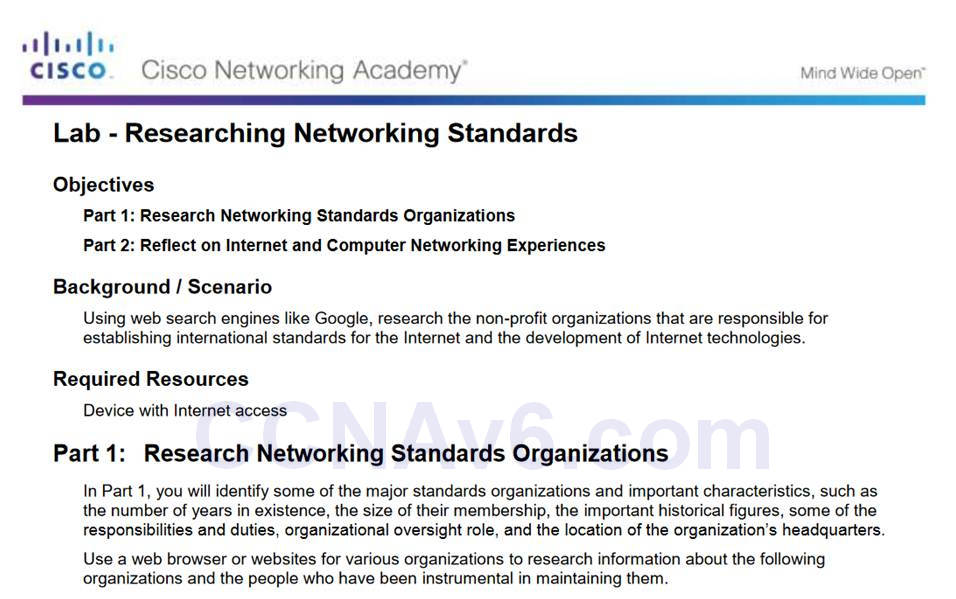
3.2.4 – Reference Models
3.2.4.1 – The Benefits of Using a Layered Model
The benefits of using a layered model include:
♦ Assisting in protocol design since protocols at each layer have defined functions.
♦ Fostering competition because products from different vendors can work together.
♦ Preventing technology changes in one layer from affecting other layers.
♦ Providing a common language to describe networking functions and capabilities.

3.2.4.2 – The OSI Reference Model
Application – contains protocols used for process-to-process communications.
Presentation – provides for common representation of the data.
Session – provides services to the presentation layer to organize its dialogue and to manage data exchange.
Transport – defines services to segment, transfer, and reassemble the data.
Network – provides services to exchange the individual pieces of data over the network between identified end devices.
Data Link – provides methods for exchanging data frames between devices over a common media.
Physical – describes the mechanical, electrical, functional, and procedural means to transmit bits across physical connections.
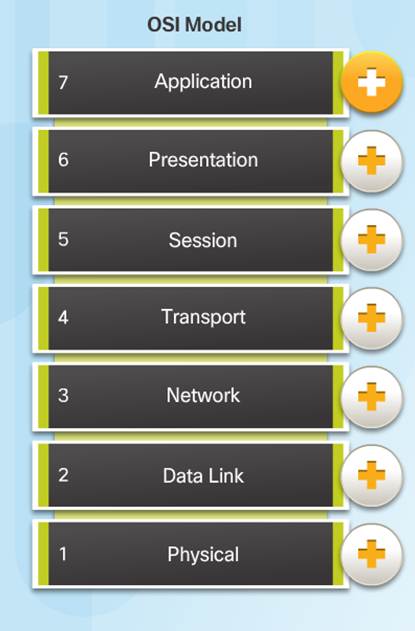
3.2.4.3 – The TCP/IP Protocol Model
The TCP/IP Protocol Model
♦ Created in the early 1970s for internetwork communications.
♦ Open Standard.
♦ Also called The TCP/IP Model or the Internet Model.
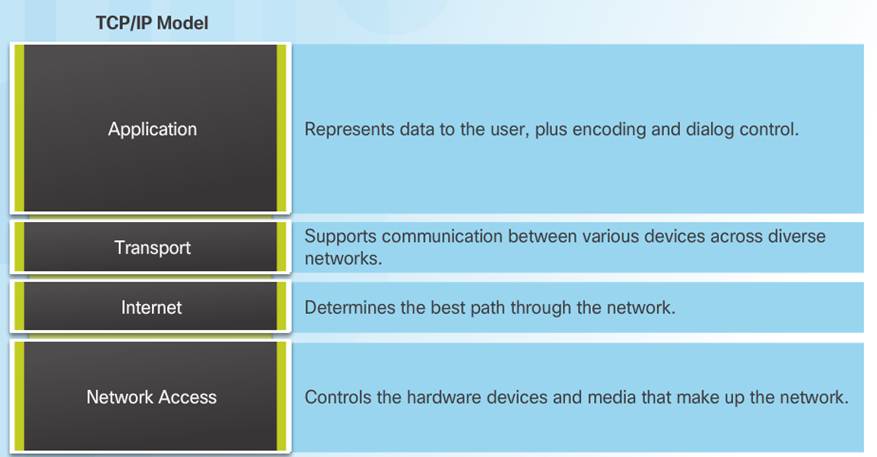
3.2.4.4 – OSI Model and TCP/IP Model Comparison
In the OSI model, the network access layer and the application layer of the TCP/IP model are further divided to describe discrete functions that must occur at these layers.
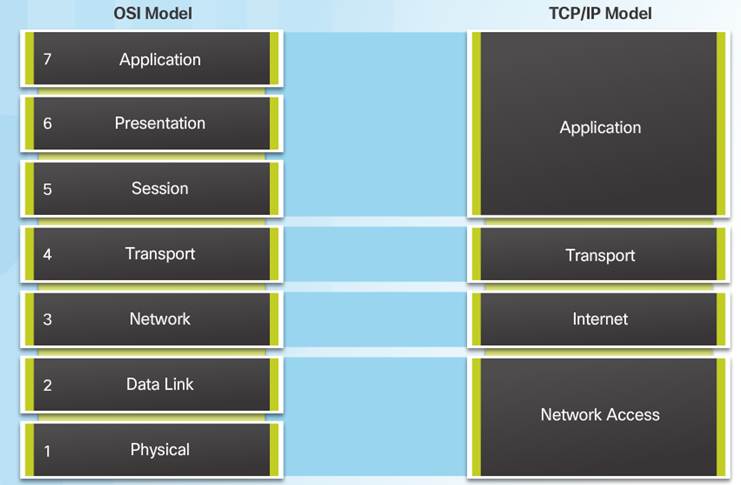
3.2.4.5 – Packet Tracer – Investigating the TCP/IP and OSI Models in Action
3.2.4.6 Packet Tracer – Investigating the TCP/IP and OSI Models in Action
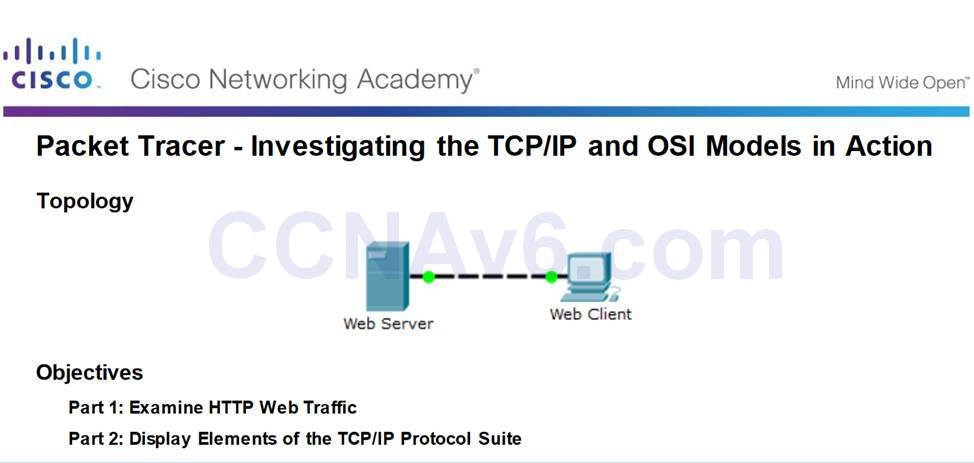
3.3 – Data Transfer in the Network
3.3.1– Data Encapsulation
3.3.1.1 – Message Segmentation
Large streams of data are divided into smaller, more manageable pieces to send over the network.
By sending smaller pieces, many different conversations can be interleaved on the network, called multiplexing.
Each piece must be labeled.
If part of the message fails to make it to the destination, only the missing pieces need to be retransmitted.
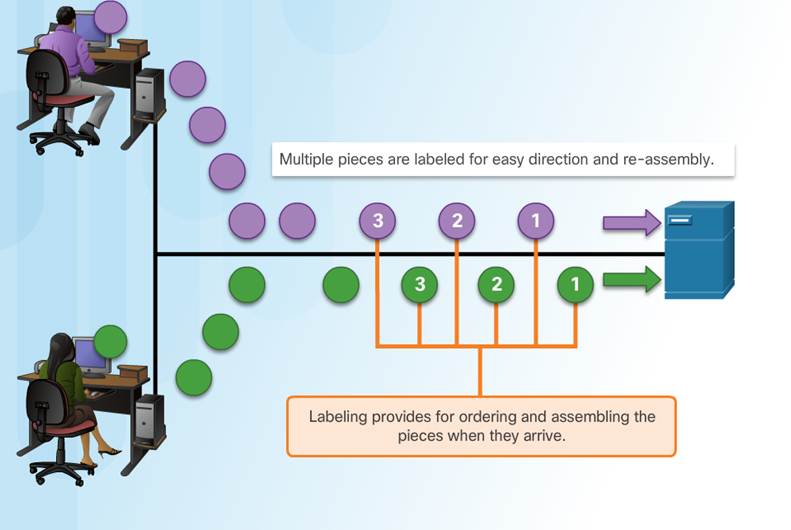
3.3.1.2 – Protocol Data Units
As application data is passed down the protocol stack, information is added at each level. This is known as the encapsulation process.
The form that the data takes at each layer is known as a Protocol Data Unit (PDU).
♦ Data – application layer PDU
♦ Segment – Transport layer PDU
♦ Packet – Network layer PDU
♦ Frame – Data Link Layer PDU
♦ Bits – Physical Layer PDU

3.3.1.3 – Encapsulation Example
The encapsulation process works from top to bottom:
♦ Data is divided into segments.
♦ The TCP segment is encapsulated in the IP Packet.
♦ The IP packet is encapsulated in the Ethernet Frame.
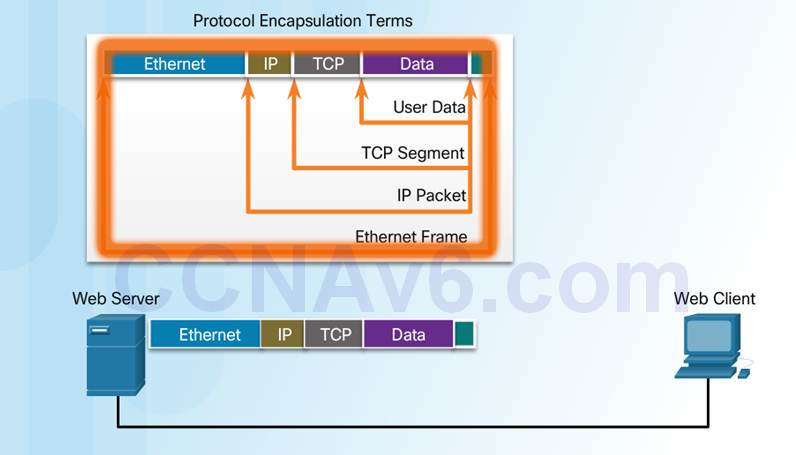
3.3.1.4 – Encapsulation Example
The de-encapsulation process works from bottom to top.
De-encapsulation is the process used by a receiving device to remove one or more of the protocol headers.
♦ The data is de-encapsulated as it moves up the stack toward the end-user application.
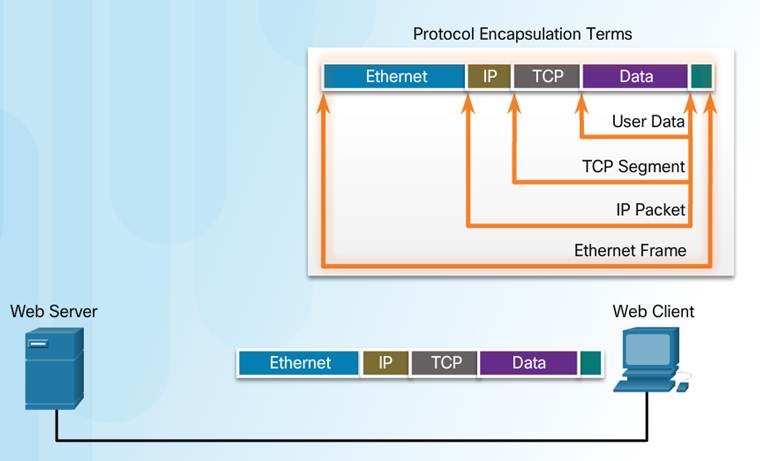
3.3.2– Data Access
3.3.2.1 – Network Addresses
Network layer source and destination addresses – Responsible for delivering the IP packet from the original source to the final destination.
♦ Source IP address – The IP address of the sending device, the original source of the packet.
♦ Destination IP address – The IP address of the receiving device, the final destination of the packet.
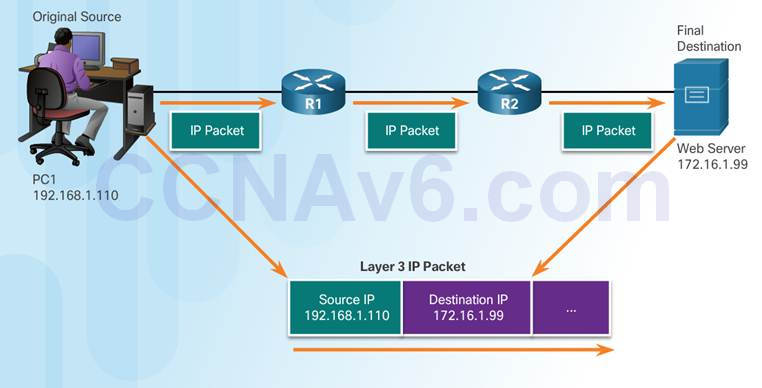
3.3.2.2 – Data Link Addresses
The purpose of the data link address is to deliver the data link frame from one network interface to another network interface on the same network.
As the IP packet travels from source to destination it is encapsulated in a new data link frame when it is forwarded by each router.
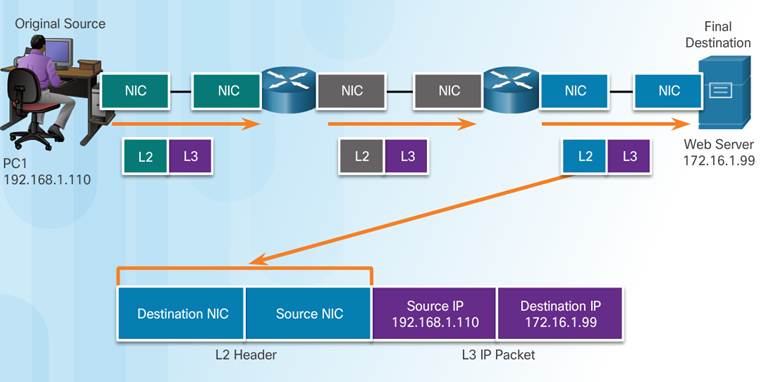
3.3.2.3 – Devices on the Same Network
The network layer addresses, or IP addresses, indicate the original source and final destination.
♦ Network portion – The left-most part of the address indicates which network the IP address is a member of.
♦ Host portion – The remaining part of the address identifies a specific device on the network.
The data link frame which uses MAC addressing, is sent directly to the receiving device.
♦ Source MAC address – address of sending device.
♦ Destination MAC address – address of receiving device.
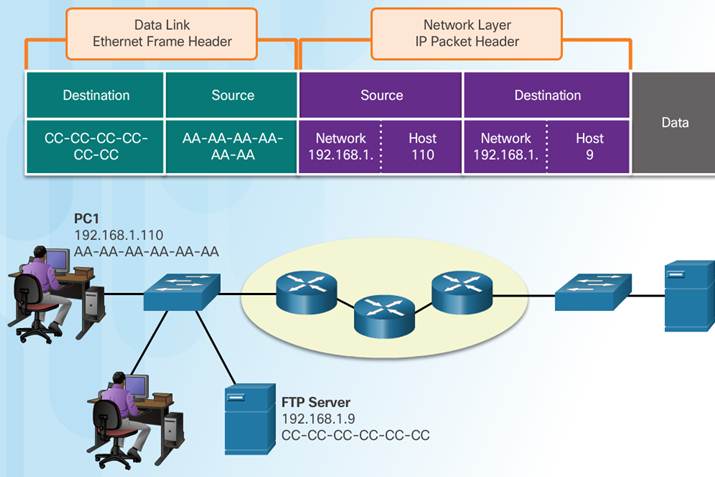
3.3.2.4 – Devices on a Remote Network
Sending to a remote network – the source and destination IP addresses represent hosts on different networks.
The data link frame cannot be sent directly to the remote destination host. Therefore the frame is sent to the default gateway (nearest router interface).
The router removes the received Layer 2 information and adds new data link information before forwarding out the exit interface.
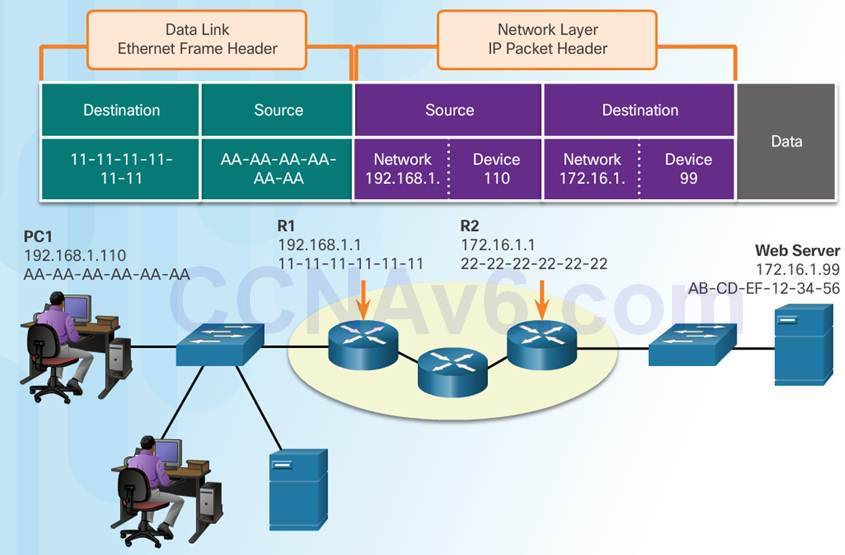
3.4 – Summary
3.4.1– Conclusion
3.4.1.1 – Lab – Installing Wireshark
3.4.1.1 Lab – Installing Wireshark
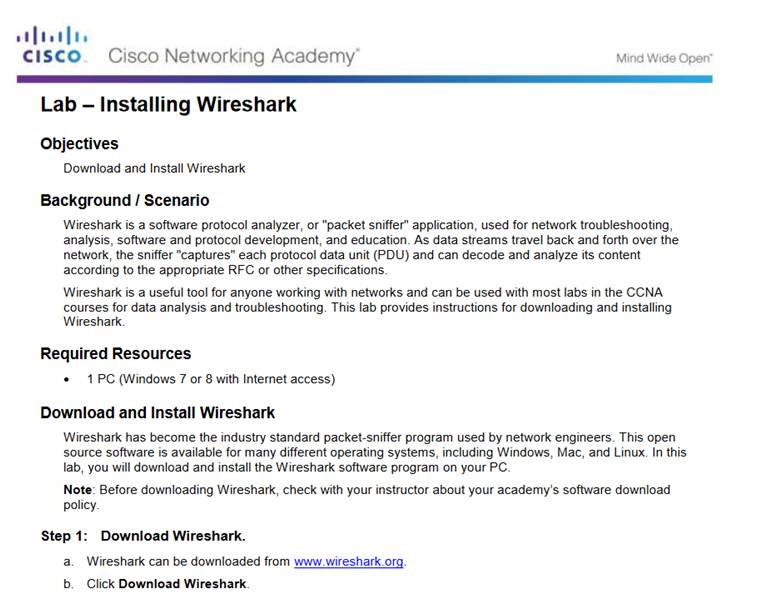
3.4.1.2 – Lab – Using Wireshark to View Network Traffic
3.4.1.2 Lab – Using Wireshark to View Network Traffic
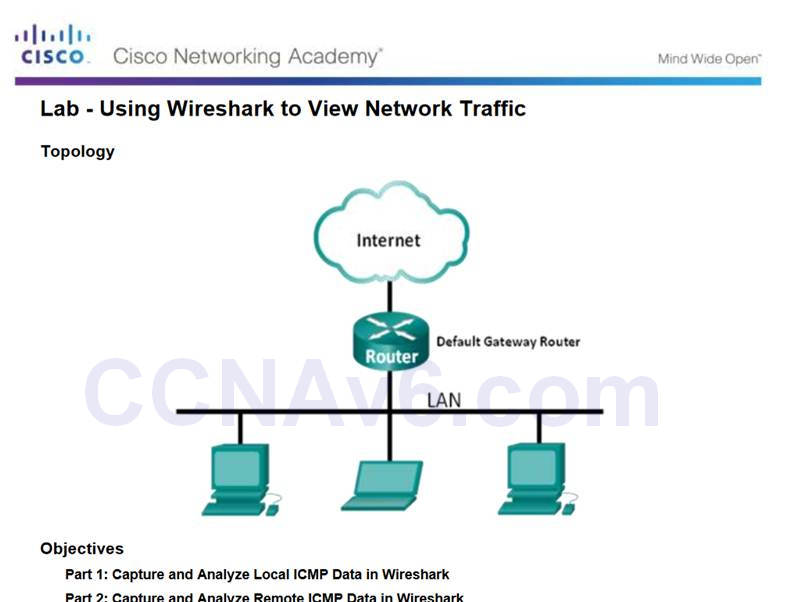
3.4.1.3 Class Activity – Guaranteed to Work!
3.4.1.3 Class Activity – Guaranteed to Work!
3.4.1.4 – Chapter 3: Network Protocols and Communications
Explain how rules facilitate communication.
Explain the role of protocols and standards organizations in facilitating interoperability in network communications.
Explain how devices on a LAN access resources in a small to medium-sized business network.
New Terms and Commands
| Encoding
Protocol Channel Flow Control Response Timeout Acknowledgement Unicast Multicast Broadcast Protocol Suite Ethernet Standard Proprietary protocol Internet Message Access Protocol (IMAP) File Transfer Protocol (FTP) Trivial File Transfer Protocol (TFTP) User Datagram Protocol (UDP) Network Address Translation (NAT) Internet Control Messaging Protocol (ICMP) Open Shortest Path First (OSPF) Enhanced Interior Gateway Routing Protocol (EIGRP) Address Resolution Protocol (ARP) Dynamic Host Configuration (DHCP) |
802.3 (Ethernet)
802.11 (Wireless Ethernet) Segmentation Default Gateway Hypertext Transfer Protocol (HTTP) Simple Mail Transfer Protocol (SMTP) Post Office Protocol (POP) Transmission Control Protocol (TCP) Transport Data Link Network Access Advanced Research Projects Agency Network (ARPANET) Encapsulation De-encapsulation Protocol Data Unit (PDU) Segment Packet Frame |
